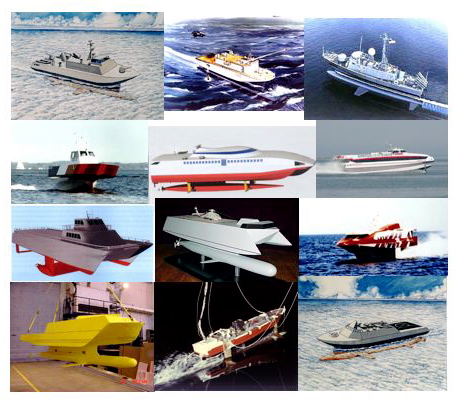Hybrid Ships and Craft - A New Breed
John R. Meyer, Jr.
An extension to the earlier publication "Ships That Fly",
The story of the modern hydrofoil.
 |
Click here to view the Table of Contents for section 1. | ||
| Click here to view the Table of Contents for section 2. | |||
"Hybrid Ships and Craft - A New Breed" is divided into two sections. |
|||
Section 1: Elaborates on Chapter 7 of "Ships That Fly"; namely, the Technical Aspects of Hydrofoils. This is done to provide the reader with some foundation on the subject of ships and craft that are supported by hydrofoils, I have covered the basics including: hydrofoil configurations, hydrofoil performance characteristics, hydrofoil features, hydrofoil design tools, and an example of design tradeoffs. Section 2: "Ships and Craft", provides a description of the genesis of Hybrid hullforms in the early 1970s. The origin of the idea, the development of early concepts, followed by Recent Designs and Vehicles that were later designed, built and tested are described. Investigations of Hybrid Surface Ship forms were started at the David Taylor Research Center (DTRC) in the 1970s under the Hybrid Marine Interface Vehicles Program. One objective of this program was to explore the advantages to be realized through conceptual hybrid surface ship platforms. The U.S. Navy studies were oriented toward military applications. These included a full range of missions utilizing various size ships from small patrol craft to 4,000 ton frigates. A vehicle having more than one source of sustention (or lift) simultaneously over a major portion of its operational speed envelope has been referred to as a "Hybrid Marine Interface Vehicle". Compared to other hullforms, Hybrid Ship concepts are relatively new. This section of the book is about what happened during the 35 years of hybrid ship development following this initial launch of Hybrid Ships and Craft - the creation of "A New Breed". The concepts described here have one characteristic in common, namely the use of foils to provide dynamic lift to augment buoyant lift. The forms include HYSWAS, Foil Assisted Catamarans, Lifting Bodies/Blended-Wing Concepts, and Tail Draggers. These arrangements will be described in turn. It should be noted that many monohulls and catamarans have been fitted with foil systems to provide motion control. These craft are not included here since they are not truly hybrid forms, the foils in these cases are not designed to produce steady state dynamic lift. |
|||
| Testimonial: |
|||
|
|||
|
|||